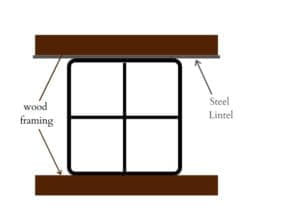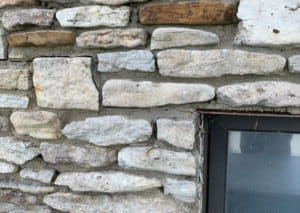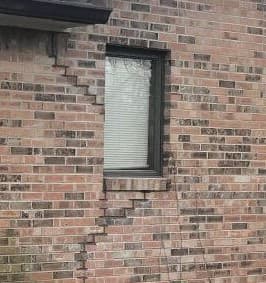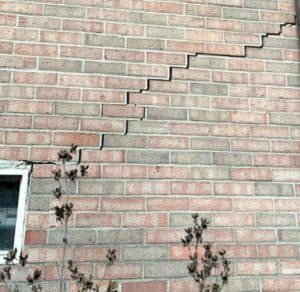English is a strange language with some bizarre pronunciations. Cereal and serial are pronounced the same way. Read and reed sometimes sound the same, but not if ‘read’ is in the past tense- then it sounds like ‘red.’ You may be wondering where I’m going with this…
I’m not a contractor, or a builder. I’m a writer. And the first time one of my project managers suggested lintels as a topic, I was really confused. To me, a lentil is a bean often cooked in soup. But I quickly discovered lentils and lintels are another example of our quirky language. Said quickly, they’re indistinguishable to the ear- but they are definitely not the same thing!
I may not be well-versed in housing components, but Acculevel has been specializing in foundation repair since 1996. Founded by Andy Beery, we’ve restored health and stability to tens of thousands of homes.
Most homeowners panic a bit when they find cracks in their foundation. But not all cracks are signs of a foundation problem. Sometimes, a rusted framing component is to blame; we’ll explain what to look for, how to repair it, and when you need a professional’s expertise.
What is a Lintel?
In some instances, a lintel can be a decorative and functional concrete piece, usually at the top of a column. But for the purposes of this article, we’re talking about a steel lintel. This is a horizontal piece of steel that spans the openings in your walls: garage doors, fireplaces, doors, windows… sometimes even above crawl space vents.
 This is the author’s extremely simplified diagram of a window’s framework.
This is the author’s extremely simplified diagram of a window’s framework.
Whenever you create an opening in a wall, it adds stress to the load-bearing header at the top of the wall. A lintels is placed across the opening to add some reinforcement and reduce the pressure on the header. It makes a sort of “bridge” for whatever masonry (stone or brick) is being laid across the opening.
How Can a Lintel Cause Problems?
Lintels are made of metal, and when metal gets wet, it rusts. Windows are designed to keep out the elements, but they aren’t 100% failsafe. Humidity is a constant companion in the Midwestern summer, and a bit of condensation collecting on your window can be enough to cause trouble.
When steel rusts, it expands significantly. Studies have shown that when the metal installed inside masonry begins to rust, it can expand up to seven times the original thickness. That is more than enough expansion to force other parts of the window frame to shift. These shifting components then exert pressure on the surrounding wall, damaging the outside of your foundation. Often, you’ll see a rusty red discoloration on the window frame where it attaches to the lintel; you may also see metal flakes or scales in the same area.
How Do You Fix a Rusted Lintel?
The lintel will need to be cut out, removed, and replaced. It should also be painted with a quality exterior paint, to seal and protect it from the elements. Another option is to replace the rusted lintel with a galvanized metal version, which will last longer than the typical steel one. If you’re a hands-on person, this is an excellent DIY project. Alternately, this is a job for a handyman, general contractor, or mason.
If the mortar around the affected window or door has cracked, you should work with a qualified local bricklayer or mason. But first, you need to be sure the lintel is the cause of the cracks. Exterior cracks in your foundation can be a sign of foundation settling, which needs to be repaired by a professional contractor.
So how do you know if the crack in your foundation is a major or minor issue? Let’s look at a few examples. (All of these photos were taken by an Acculevel project manager, during a routine estimate appointment.)
 If you look closely, you can see the discoloration and scaling in the corner of the lintel, as well as some hairline cracks around the surrounding stones. This is a lintel issue.
If you look closely, you can see the discoloration and scaling in the corner of the lintel, as well as some hairline cracks around the surrounding stones. This is a lintel issue.
 The cracks around this window are wider, stair-stepped, and are not occurring near the lintel. This is a sign of settling, and the home needed helical piers to stabilize the foundation.
The cracks around this window are wider, stair-stepped, and are not occurring near the lintel. This is a sign of settling, and the home needed helical piers to stabilize the foundation.
 This is another instance of settling. Even though the crack originated near the lintel, there are no signs of rust. The crack has also widened and expanded up towards the corner of the home, not remaining in close proximity to the window.
This is another instance of settling. Even though the crack originated near the lintel, there are no signs of rust. The crack has also widened and expanded up towards the corner of the home, not remaining in close proximity to the window.
Still Not Sure if the Issue is a Lintel or Settling?
Don’t be too hard on yourself. If you catch this problem early on, diagnosis can be tricky for a homeowner. There are additional signs you can look for:
- Check inside the house. Are there any cracks in the drywall, on the corresponding interior wall?
- If the answer is yes, check the doors and windows in that area. Do they open and close smoothly? Sticking doors or jammed windows are a sign that you have a settling issue and should contact a professional.
- If you answered no to #1, it’s most likely a lintel issue. And this may be an obvious bit of advice, but if there’s any water getting in around the window or door, you need to get that fixed promptly.
Additional Resources
We have a free DIY foundation inspection checklist, which I recommend to every homeowner. Based on Acculevel’s own 21 Point Inspection, this checklist will help you catch any developing problems before they become issues that require expensive repairs. We suggest that this ‘check-up’ should be done each spring and fall.
Do you have other questions about your foundation? Does something seem odd to you, but you’re not sure if it’s a problem? We have a Symptom Checker that can be (freely!) consulted for more information and insight.
If you need to hire a contractor for repair work on your home- any kind of work- I urge you to use our guide, Questions to Ask a Contractor. The article includes Acculevel’s answer to these questions, as well as warning signs or red flags to watch for. Every industry has a few bad apples; we don’t want anyone to be cheated or scammed by an unethical person posing as a quality contractor.
Do You Need Foundation Repair?
If you live in Indiana or the surrounding states, contact Acculevel. We specialize in foundation repairs and provide free estimates to all our customers. Contact our office, and one of our friendly office staff will schedule an appointment for you with an experienced project manager. He or she will evaluate your house and its symptoms, then recommend the best course of action for you, to keep your home strong and healthy for years to come.
Acculevel’s goal is to do the best and most thorough repair possible, to protect and maintain your home. We treat every customer’s home as if it is our own. Allowing our employees into your home demonstrates trust, and we intend to repay that trust with the absolute best in customer service. We are accredited by the BBB, have an A+ rating, and average 5 stars on customer reviews.



















